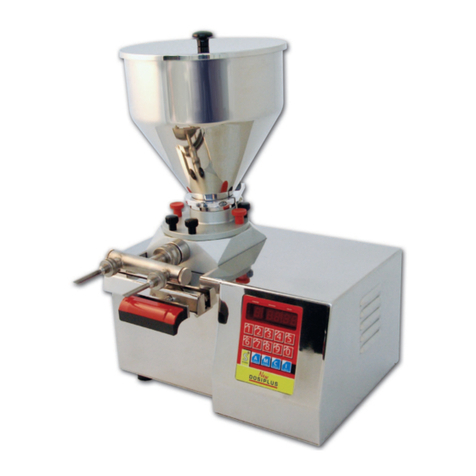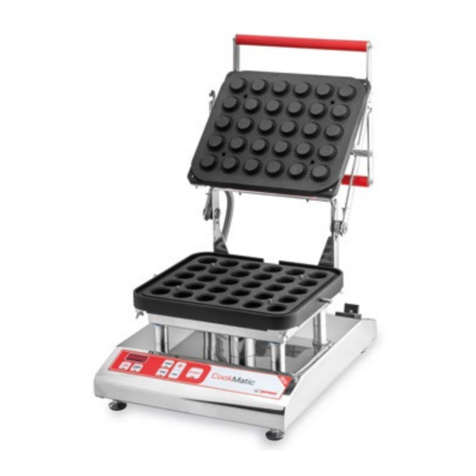
28 | FR
Programmation
Programmes (niveau de température–temps de pause)
La machine dispose de cinq programmes: Pr1 – Pr2 – Pr3 – Pr4 – Pr5. Chaque programme s’articule sur
trois phases, chaque phase contient: un niveau de température (de 20°C à 60°C avec augmentation de 0,5°C)
et un temps de pause (de 00,5 minutes à 50,0 minutes avec augmentation de 00,5 minutes=30 secondes),
exemple:
1° phase (fonte)
• l’écran afche SP1 pour indiquer le 1er niveau de température en °C;
• l’écran afche PA1 pour indiquer le 1er temps de pause en minutes;
2° phase (cristallisation)
• l’écran afche SP2 pour indiquer le 2° niveau de température en °C;
• l’écran afche PA2 pour indiquer le 2° temps de pause en minutes;
3° phase (tempérage)
• l’écran afche SP3 pour indiquer le 3ème niveau de température en °C;
• l’écran afche PA3 pour indiquer le 3ème temps de pause en minutes;
Comment entrer dans le programme
Si on appuie sur la touche P (voir clavier), le programme afché à l’écran passe de Pr1 àPr5. Une fois choisi
un des 5 programmes choisi, appuyer environ 8 secondes sur la touche P pour entrer dans le programme
souhaité. Le choix du programme effectué est signalé par le voyant lumineux vert clignotant (en haut à droite
de la touche P). Le voyant lumineux clignote pendant la phase de programmation et ne clignote plus durant
la phase de travail (cycle de travail).
Conguration du programme
Après avoir appuyé sur la touche P, l’écran afche: SP1 (1°
phase-1° niveau de température) pendant une durée de 3
secondes. L’écran afche ensuite soit la valeur de la température
préalablement congurée soit aucune valeur, ce qui signie que
la température est à congurer. Pour congurer ou modier
la température (dans le champ entre 20°C et 60°C avec une
augmentation de 0,5°C), actionner les touches + / - situées sur le
clavier. Pour conrmer, appuyer sur la touche P.
Après conrmation, l’écran afche: PA1 (1° phase-1° temps de
pause) pendant trois secondes. Puis, l’écran afche soit le temps
préalablement conguré soit aucune valeur, auquel cas le temps
est à congurer. Pour congurer ou modier le temps (dans le
champ entre 00,5 et 50,0 minutes avec une augmentation de
00,5=30 secondes), actionner les touches + / - situées sur le
clavier. Pour conrmer, appuyer sur la touche P.Clavier de la machine
FR | 29
L’écran afche: SP2 (2° phase-2° niveau de température) pendant une durée de 3 secondes, après quoi l’écran
peut afcher la valeur de la température préalablement congurée ou bien aucune valeur, ce qui signie que la
température est à congurer. Pour congurer ou modier la température (dans le champ entre 20°C et 60°C
avec une augmentation de 0,5°C), actionner les touches + / - situées sur le clavier. Pour conrmer, appuyer
sur la touche P.
L’écran afche: PA2 (2° phase-2° temps de pause) pendant trois secondes, puis l’écran afche soit le temps
préalablement conguré soit aucune valeur, auquel cas congurer le temps. Pour congurer ou modier le
temps (dans le champ entre 00,5 et 50,0 minutes avec une augmentation de 00,5=30 secondes), actionner
les touches + / - situées sur le clavier.Pour conrmer, appuyer sur la touche P.
L’écran afche: SP3 (3° phase-3° niveau de température) pour une durée de 3 secondes, après quoi l’écran
peut afcher la valeur de la température préalablement congurée ou bien aucune valeur: congurer la
température. Pour congurer ou modier la tem-pérature (dans le champ entre 20°C et 60°C avec une
augmentation de 0,5°C), actionner les touches + / - situées sur le clavier. Pour conrmer, appuyer sur la
touche P.
L’écran afche: PA3 (3° phase-3° temps de pause) pendant trois secondes, puis l’écran afche soit le temps
préalablement conguré soit aucune valeur, auquel cas le temps est à congurer. Pour congurer ou modier
le temps (dans le champ entre 00,5 et 50,0 minutes avec une augmentation de 00,5=30 secondes), actionner
les touches + / - situées sur le clavier. Pour conrmer, appuyer sur la touche P.
Comment quitter le programme
Après avoir conrmé la troisième phase à l’aide de la touche P, quitter la phase de programmation et le
voyant lumineux se mettra à clignoter.
ATTENTION: Les valeurs des niveaux de température SP1 e SP3 doivent être des valeurs supérieures
à celles de SP2 (puisque SP2 est une phase de travail au niveau de température le plus bas). Dans le cas
contraire, la machine émet un son et les valeurs congurées ne seront pas acceptées. Il est nécessaire
d’introduire d’autres valeurs.
Nouvelle machine
La machine est dotée de trois programmes déjà sélectionnés relatifs à trois types de chocolat; ces programmes
peuvent toutefois être modiés. Les données relatives aux trois programmes sont reportées sur une che
fournie avec la machine, voir page 30.
Préparation de la machine
Introduction du produit
• ôter le couvercle (05);
• introduire le produit, capacité maximale de 3,50 kg. (valeur nominale du bac 5 litres);






































